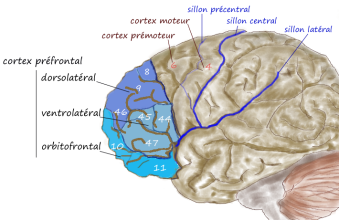This study helps to explain how dysfunction in the prefrontal cortex might make people more susceptible to violent and/or impulsive behaviours.
Similar to the VHIS, Ciaramelli et al investigated the differences between moral judgements in people with damage to their prefrontal cortex and healthy controls. Their study cites existing research that suggests people with damage to their PFC have “high levels of aggressiveness, lack of concern for social and moral rules and irresponsibility.” Because of the PFCs role in deliberating over moral dilemmas and making decisions with serious and emotional consequences, especially those of a social nature (i.e. they will affect other people), the researchers hypothesized that the brain damaged patients would be more likely to approve moral violations in personal moral dilemmas. For instance, in the trolley/footbridge example they would be more likely to push the person off the footbridge to save the five people than the controls.

Here you can see that within the frontal lobe is the prefrontal cortex and within the cortex there are further sub-regions, like the ventrolateral PFC and the orbitofrontal PFC.
Because the PFC also helps to regulate our impulsivity and helps us to make long-term decisions and plans, it was also expected that the patients would have quicker response times.
They did not anticipate a difference in the non-moral dilemmas because these do not require the same level of cognitive processing as the moral dilemmas.
The participants were 7 brain-damaged patients who had damage in a specific area of their PFC (the ventromedial prefrontal cortex). Their brain damage occurred as a result of having an aneurysm. The patients had a mean age of 55 and 10 years of education – the controls were matched for these criteria (mean age 57 years and 12 years of education).
The participants were shown 45 dilemmas – 30 moral (15 personal and 15 impersonal) and 15 non-moral dilemmas. They did not take the test in the fMRI because MRIs had already been used to identify the location of the damage to their brains. The DV in this experiment was their response to the different scenarios and their time taken.
The results of the healthy controls were similar to previous studies:
- Personal moral violations: they were slow to approve, quick to condemn
- Approved fewer personal moral violations than impersonal ones
However, in comparison, the patients with PFC damage approved more personal moral violations than the controls and they did so more quickly (around 9 seconds compared to around 13 seconds). There were no significant differences in their responses or the time taken to make them in the impersonal and non-moral decisions.
This study provides some plausible explanations for just how our biology (e.g. the PFC) can influence our behaviour (e.g. aggression, violence) through its functions in our cognition (influencing our moral judgements and ability to think through consequences).
Critical Thinking Question:
How can our behaviour be explained through the relationship between biology and cognition?
(link)
The following video shows an example of a man who had an aneurysm which damaged his frontal lobe. This is another example of the frontal lobe’s ability to carry out complex cognitive tasks, such as problem solving.
Travis Dixon is an IB Psychology teacher, author, workshop leader, examiner and IA moderator.